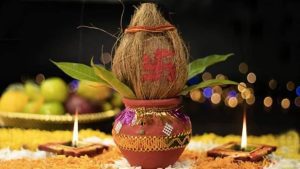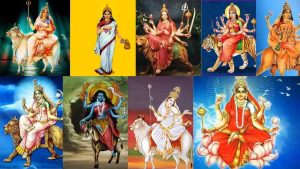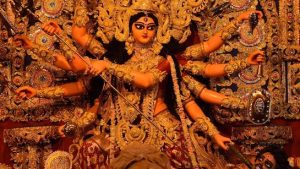Chaitra Navratri, also known as Vasant Navratri, is a significant Hindu festival that lasts for nine days. It is dedicated to Goddess Durga, the divine feminine energy that governs the universe. This festival is observed during the Chaitra month of the Hindu lunar calendar, which usually falls in March or April. In 2025, Chaitra Navratri will begin on March 30 and conclude on April 7, with Ram Navami—the celebration of Lord Rama’s birth—falling on April 6.
Navratri, which means “nine nights,” is a time for spiritual purification, devotion, and celebrating the triumph of good over evil. Unlike Sharad Navratri (celebrated in autumn), Chaitra Navratri marks the beginning of the Hindu New Year in many regions, making it even more significant.
Significance of Chaitra Navratri
Chaitra Navratri holds immense religious and cultural importance in Hinduism. The festival is rooted in ancient mythology and symbolizes the victory of Goddess Durga over the demon Mahishasura, reinforcing the idea that righteousness always prevails.
For devotees, Chaitra Navratri is also a period of self-discipline, spiritual awakening, and purification. It is believed that worshiping Maa Durga during these nine days removes negativity and ushers in prosperity, happiness, and well-being.
This festival also aligns with the seasonal transition from winter to spring, signifying renewal, new beginnings, and positivity. In many Indian states, Chaitra Navratri marks the Hindu New Year, celebrated as Gudi Padwa in Maharashtra, Ugadi in Andhra Pradesh and Karnataka, and Navreh in Kashmir.

Rituals and Traditions of Chaitra Navratri
Navratri celebrations vary across India, but some common rituals remain the same. These include fasting, daily prayers, and the worship of the nine forms of Goddess Durga.
1. Ghatasthapana (Kalash Sthapana) – Invocation of the Goddess
The festival begins with Ghatasthapana, a sacred ritual where a kalash (earthen pot) filled with holy water, mango leaves, and a coconut is placed at the puja altar. A small barley plantation is also sown near the kalash, symbolizing growth and prosperity.
This ritual marks the invocation of Goddess Durga and must be performed at an auspicious time determined by the Drik Panchang.


2. Nine Forms of Goddess Durga Worshipped Each Day
Each day of Navratri is dedicated to a different manifestation of Durga, known as Navadurga:
- Shailputri – Goddess of strength and nature
- Brahmacharini – Symbol of wisdom and penance
- Chandraghanta – Embodiment of bravery and grace
- Kushmanda – Creator of the universe
- Skandamata – Goddess of motherly love
- Katyayani – Fierce warrior form
- Kalaratri – Destroyer of darkness and evil
- Mahagauri – Goddess of purity and tranquility
- Siddhidatri – Bestower of divine knowledge
Devotees recite the Durga Saptashati and offer bhog (sacred food/Prasad) to the goddess daily.
3. Fasting and Dietary Rules
Many devotees observe a strict fast (vrat), consuming only fruits, milk, and special fasting grains like kuttu (buckwheat) and singhara (water chestnut flour). Foods such as onion, garlic, and non-vegetarian items are avoided in satvik pooja padhat. Some devotees follow a nirjala vrat (waterless fast), while others eat once a day.
4. Kanya Puja – Worship of Young Girls
On the eighth (Ashtami) or ninth (Navami) day, a ritual called Kanya Puja is performed. In this ceremony, nine young girls, symbolizing the Navadurga, are worshipped and offered prasad, which includes puri, chana, and halwa. This ritual is believed to bring immense blessings and prosperity.
5. Ram Navami – The Birth of Lord Rama
The final day of Chaitra Navratri coincides with Ram Navami, celebrating Lord Rama’s birth, an incarnation of Vishnu. Devotees recite the Ramayana, perform special aartis, and organize grand processions in places like Ayodhya, the birthplace of Lord Rama.
Regional Celebrations of Chaitra Navratri


While Navratri is celebrated across India, different regions follow unique customs:
- North India: Devotees observe fasting and visit temples. Huge Ram Navami processions take place.
- Maharashtra: Chaitra Navratri marks the beginning of the New Year (Gudi Padwa), where people hoist a Gudi flag outside their homes for good luck.
- West Bengal and Odisha: Though Durga Puja is mainly celebrated in Sharad Navratri, temples perform special Durga aartis during this time.
- South India: This festival aligns with Ugadi, the New Year in Karnataka, Andhra Pradesh, and Telangana.
- Kashmir: The New Year is known as Navreh, where families prepare a special thali with rice, walnuts, and sacred scriptures.
Do’s During Chaitra Navratri
Perform daily prayers, rituals and aarti to seek Goddess Durga’s blessings.
Observe fasts with Fruits.
Offer flowers, fruits, and bhog to the goddess every day.
Recite Durga Saptashati or Ramayana for divine blessings.
Engage in charity, helping the needy during this auspicious period.
Also Read : Gudi Padwa 2025: Celebrating Maharashtra’s New Year with Tradition and Joy
Chaitra Navratri is not just a festival; it is a time of spiritual reflection, renewal, and devotion. This sacred period allows devotees to reconnect with divine energy, seek Goddess Durga’s blessings, and embrace new beginnings.
As Chaitra Navratri 2025 approaches, let us immerse ourselves in its traditions, offer prayers with sincerity, and welcome the Hindu New Year with faith, hope, and positivity.
May Goddess Durga bless everyone with happiness, prosperity, and inner strength!

